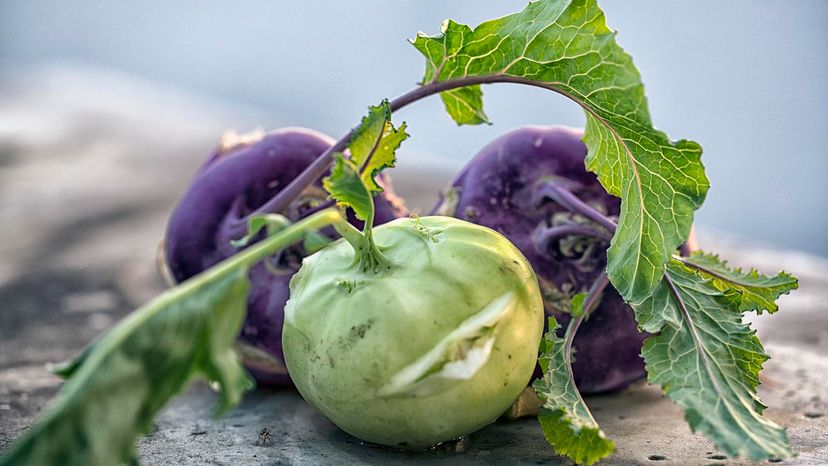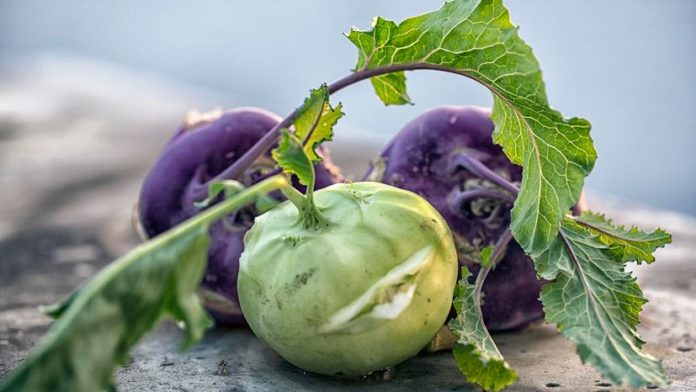 “The bulb, stems and leaves of kohlrabi are all edible, but the outer peel is bitter and should be peeled off first. gaffera/Getty Images
“The bulb, stems and leaves of kohlrabi are all edible, but the outer peel is bitter and should be peeled off first. gaffera/Getty Images
The produce aisle has an emerging star that’s filling shopping carts left and right: kohlrabi. This cruciferous vegetable — a member of the cabbage family — boasts a sweet flavor that’s a blend of water chestnuts and turnips. And the latter is hardly surprising; the German word "kohlrabi" actually translates to "turnip cabbage" in English.
Now, kohlrabi is hardly new to the vegetable world — but it is newish. Kohlrabi wasn’t discovered until around 500 years ago in northern Europe, and it didn’t make its way to the U.S. until the early 1800s. And thank goodness it did, because this peculiar looking vegetable is chock-full of health benefits. Here’s everything you need to know about kohlrabi, the slightly sweet and healthy crucifer you need in your life.
How to Buy Kohlrabi
Before cooking with kohlrabi, let’s talk about buying it. Kohlrabi is available in the produce aisle at most grocery stores. It sells year-round, although it reaches its peak during winter. Look for kohlrabi that are free from blemishes and cracks, and press to make sure the bulb is firm.
You can store kohlrabi for up to five days in the refrigerator crisper. And, when it’s time for cooking, make sure to peel the tough outside of the bulb with a vegetable peeler. With prep taken care of, it’s time for the good stuff.
Cooking With Kohlrabi
With kohlrabi, there’s no need to worry about wasted parts. The stems and leaves are both edible. This gives cooks ultimate creativity when it comes to kohlrabi concoctions — whether it’s a simple side or a crunch to punch-up the main.
So which dishes work best with kohlrabi? Recipes run the gamut, but are similar to most cabbage dishes. It works great as a raw snack with vegetable dip, as a crunch in homemade veggie burgers, as the cabbage alternative in a slaw. And an even healthier vegetable alternative? Kohlrabi fries, according to Fine Dining Lovers. Salads and roasted vegetables are other delicious kohlrabi options.
Kohlrabi Is Packed With Nutrients
If the subtly sweet taste didn’t entice you, the health perks surely will. Kohlrabi has a mere 36 calories per cup with 93 percent of the daily required vitamin C. It’s also an antioxidant that supports everything from immune health and iron absorption to wound healing and collagen synthesis.
Beyond its antioxidant powers, kohlrabi is packed with potassium to aid heart health and fluid balance. Its fiber content, roughly 17 percent of your daily fiber requirements, aids gut health and prevents heart disease and obesity.
How to Grow Kohlrabi
While kohlrabi is available is available at most grocery stores, that’s not the only place to get it. You can grow kohlrabi in your own vegetable garden, too. In regions with cold winters, it’s best to plant in the summer for an early fall harvest. In warmer climates, plant for a late fall or early winter harvest.
NOW THAT’S INTERESTING
Most kohlrabi plants weigh about half a pound (226 grams) when harvested, but that didn’t stop Alaskan grower Scott Robb from testing the limits with the world-record 96-pound (43.5-kilogram) kohlrabi for the Alaska State Fair.








































